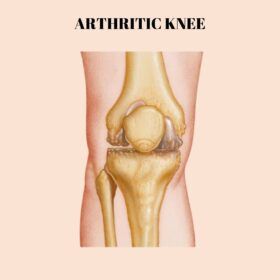
KNEE REPLACEMENT also called as KNEE ARTHROPLASTY. It is a surgical procedure to resurface a knee damaged by arthritis. Metal and plastic parts are used to cap the ends of the bones that form knee joints, Along with knee cap.
|
The surgery helps ease pain and make the knee work better. This surgery may be considered for someone who has SEVERE ARTHRITIS OR SEVERE KNEE INJURY.
To decide whether a Knee replacement is right for you, a surgeon checks your knee’s range of motion, stability and strength, X-rays show the extent of damage.

Causes: The most common cause of chronic knee pain and disability is ARTHRITIS.
Most knee pain is caused by three types of arthritis
OSTEOARTHRITIS: This is Age -Related wear and tear type of arthritis. Mostly seen in 50 years of age and older but may occur in younger people too. The Cartilage that cushions the bones of knee softens and wears away the bone then rubs against each other and causes pain and stiffness.
RHEUMATOID ARTHRITIS: Rheumatoid arthritis also called as “Inflammatory arthritis. In this disease SYNOVIAL MEMBRANE that surrounds the joint becomes inflamed and thickened. This chronic inflammation can damage the cartilage and eventually cause cartilage loss, pain and stiffness.
POST TRAUMATIC ARTHRITIS: This is due to serious knee injury. Fractures of bones surrounding knee or tear of knee ligaments may damage articular cartilage causing knee pain and limiting the knee function.

ANATOMY OF KNEE:
The knee is 2 long leg bones held together by muscles, ligaments and tendons. Each bone end is covered with a layer of cartilage that absorbs shock and protects knee.
There are 2 muscles involved in knee Quadricep Muscles (located on the front of thigh) which straightens the legs. Hamstring Muscles (located on the back of thigh) which bend the leg at knee.
Tendons are tough cords of connective tissue that connects muscles to bones Ligaments are elastic bands that connects bone to bone (some provide stability and protection of joints, while other ligaments provide forward and backward movement of Tibia (shin bone)
Knee consists of following:
TIBIA- Shin bone or larger bone of lower leg
FEMUR- Thigh bone or upper leg bone
PATELLA- Knee Cap
CARTILAGE-Tissue that covers the bone at the joint. It helps reduce friction of movement within joint
SYNOVIAL MEMBRANE-Tissue that lines the joint and seals it into a joint capsule. This membrane secretes synovial fluid which helps in lubrication of joints
LIGAMENT-Tough , elastic connective tissue that surround the joint to give support and limits the joint’s movement
TENDON- Tough connective tissue that connects muscles to bones and control movement of joint
MENISCUS- A curved part of cartilage in knees and joints that act as shock absorber.
